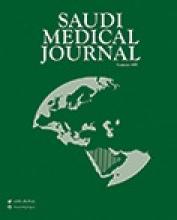To the Editor
I have read with interest the study by Al-Agha et al1 published in June 2019 issue of the Saudi Medical Journal. The authors studied the determinants of bone mineral density (BMD) through screening healthy Saudi children using a quantitative ultrasound (QUS). They found a significant association with BMD during first 2 years with height (p=0.015), breastfeeding (p=0.025), and vitamin D supplementation (p=0.03). They also found a directly proportional relationship with BMD with pubertal status, diet, physical activity, sun exposure, and calcium supplement intake.1 Apart from the 2 study limitations addressed by the authors, I assume that the following methodological limitation might additionally cast suspicions on the accuracy of the study results. In the methodology, the authors mentioned that the recorded speed of sound (SOS) value was converted to a Z score using the manufacturer’s data bank for age and gender matched SOS values for the left (SOS-L) and right (SOS-R) radii. Participants were regarded to screen positively for osteoporosis if their recorded Z score was -2 or below.1 It is explicit that the precise evaluation of BMD in a given pediatric population requires the employment of population-specific QUS reference values (RV) for age and gender. In fact, QUS BMD normative values have been constructed for certain pediatric populations.2-5 Evaluation of various QUS BMD RV revealed noticeable differences in SOS-RV in different pediatric populations.6 Therefore, the construction of Saudi QUS BMD RV deems essential and the employment of that national RV in the clinical fields and researches could yield a better idea on bone health status in the Saudi pediatric population
Reply from the Author
No reply was received from the author.
- Copyright: © Saudi Medical Journal
This is an open-access article distributed under the terms of the Creative Commons Attribution-Noncommercial-Share Alike 3.0 Unported, which permits unrestricted use, distribution, and reproduction in any medium, provided the original work is properly cited.






